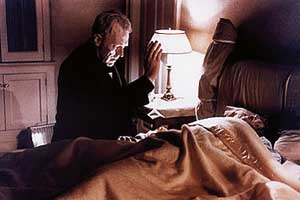Scholars to delve into mystery of ‘the spirit within,’ search for origin
By Jennifer CarnigNews Office
 A scene from the film The Exorcist shows the character Father Merrin praying over the possessed body of Regan. | |
It was The Exorcist that made the devil famous, but tales of demon possession have been around a lot longer than Linda Blair. Narratives of possession and exorcism are recurrent historical phenomena in the Mediterranean world, beginning in the first century and continuing down until modern times. But their precise origin and prehistory are unknown.
To further examine this mystery, the University will hold a three-day conference, “The Spirit Within: Inspiration, Possession and Disease in the Ancient Mediterranean Basin,” which will begin Friday, March 4, and continue through Sunday, March 6.
Leading scholars from around the world—from as close as Northwestern University and the University of Michigan to as far away as Royal Holloway University of London and the University of Florence—will come together with an interdisciplinary cross-section of Chicago faculty to grapple with the same question: When and where did the idea of the indwelling demon emerge?
Although the history of the indwelling demon is well documented in the common era—demons appear in the New Testament, when Jesus casts a spirit called Legion out of a mentally deranged man, and in the work of such Roman-era authors as Lucian and Plutarch—its precise origins remain obscure, explained conference organizer Christopher Faraone, Professor in Classical Languages & Literatures and the College.
Since the Greeks in pre-Roman times generally thought demons caused illness by attacking their victims from the outside by striking or strangling a person, and since the first reports of exorcism occur in the Levant and Anatolia, classicists have generally assumed that the idea of an indwelling demon—one blamed for stroke, epilepsy, mental illness and the like—is borrowed from the Near East in the first century. However, Biblical and Near Eastern scholars point out that one cannot trace this idea in the East prior to the late Hellenistic period.
“As a classicist, I’ve always thought the idea comes from the East, but my friends who study the Hebrew Bible say that it doesn’t really appear in the Near East until after the Greeks arrive. So we really have no idea where this comes from,” Faraone said. “That’s why we’re having this conference, so we can figure it out. As of now, nobody has a good answer.”
Faraone’s own work focuses specifically on a bizarre idea that arose in the Mediterranean under the Roman Empire—that a woman’s womb needed to be exorcized as if it were an indwelling demon. This idea is apparently adapted from an earlier theory, found first and most famously in Plato but also to some degree in the Hippocratic doctors, that the womb could freely wander about the body and cause illness by colliding with other internal organs. In the Roman period, however, women who suffered from stroke or mental illness, Faraone explained, were believed to have a demonic womb that willfully attacked their internal organs. The womb eventually began to be addressed in the same way a demon is with a formula for exorcism. Thus in the Roman period, amulets inscribed with the command “stay where you belong, womb” began to be used and were said to prevent the demonic womb from moving and attacking the other organs in the body.
On a different end of the spectrum, Bruce Lincoln is presenting research on the muse. Lincoln, the Caroline E. Haskell Professor in the Divinity School, has been studying the work of the epic Greek poet Hesiod.
In “Kings, Poets and Inspiration: On the Ideology and Physiology of Authoritative Speech in Hesiod,” Lincoln will look at the invocation of deities called the muses, the inspiration behind poetry and the source of all knowledge, and ask how inspiration gets into the muse.
It may seem odd to pair a lecture on the muse with a conference on demons, but Faraone disagrees. “People have looked at poetic inspiration, prophetic inspiration, demon possession and illness in a way that has made it impossible to see the commonalities. The point of this conference is to look at many different instances in which gods or demons are thought to enter a human body, for good or evil, and to see if we’re missing any connections between them.”
Other faculty members participating in the conference are co-organizer Campbell Grey, Visiting Assistant Professor in History and the College, presenting “Possessed, Goaded or Inspired? Defining and Locating Demons in the Late Antique West;” Donald Harper, Professor in East Asian Languages & Civilizations, presenting “The Human Body, Spirits and Demonifugal Practices in Third Century B.C.E. Chinese Manuscripts;” and James Redfield, the Edward Olson Distinguished Service Professor in Classical Languages & Literatures and the College, who will present “The Daimonion of Socrates.”
The conference is free and open to the public. It runs from 4 to 7 p.m. Friday, March 4, 9 a.m. to 9 p.m. Saturday, March 5, and 9 a.m. to 2 p.m. Sunday, March 6, at the Franke Institute for the Humanities, 1100 E. 57th St. For more information or a complete schedule of events, e-mail azbryen@uchicago.edu.
![[Chronicle]](/images/sidebar_header_oct06.gif)